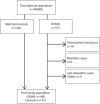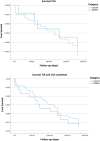Assessing risk of stroke after idiopathic sudden sensorineural hearing loss using data from general practice
- PMID: 38693206
- PMCID: PMC11063204
- DOI: 10.1038/s41598-024-59934-3
Assessing risk of stroke after idiopathic sudden sensorineural hearing loss using data from general practice
Abstract
The cause of sudden sensorineural hearing loss (SSNHL) remains unknown in a significant number of cases, but vascular involvement in its pathophysiology has been proposed. Our study aimed to assess the incidence of stroke following idiopathic SSNHL (iSSNHL) and to evaluate associated cardiovascular risk factors and comorbidities. We extracted electronic medical record data from iSSNHL patients aged ≥ 50 years retrospectively from 84 general practices. Patients were matched for age, sex and general practice in a 1:4 ratio to controls. Primary outcome was the 5-years stroke risk following iSSNHL diagnosis. 480 iSSNHL cases could be matched to 1911 controls. The hazard ratio for iSSNHL compared with controls was 1.25 (95%CI 0.50-3.27; P = 0.646) for CVA (cerebrovascular accident) alone and 0.92 (95% CI 0.50-1.71; P = 0.804) for CVA and TIA (transient ischemic attack) combined. The hazard ratio for the interaction term between iSSNHL and age ≥ 60 years was 4.84 (95% CI 1.02-23.05; P = 0.048) for CVA and TIA combined. Patients with iSSNHL used antihypertensives and beta-blocking agents more frequently than controls (P = 0.006 and P = 0.022, respectively). In conclusion, no overall significant difference in the risk of stroke was observed, but the hazard ratio for stroke increased in iSSNHL patients aged 60 and older, suggesting potential vascular involvement in older subjects presenting with sudden sensorineural hearing loss.
Keywords: Cardiovascular risk; General practice; Idiopathic sudden sensorineural hearing loss; Stroke.
© 2024. The Author(s).
Conflict of interest statement
The authors declare no competing interests.
Figures


References
-
- Ciorba A, et al. Sudden hearing loss and the risk of subsequent cerebral ischemic stroke. B-ENT. 2015;11:205–209. - PubMed
Publication types
MeSH terms
LinkOut - more resources
Full Text Sources
Medical

